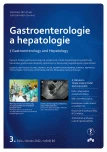Endosonography in the diagnostics of choledocholithiasis
Authors:
T. Chvátalová; J. Martínek; F. Závada; M. Zavoral
Authors‘ workplace:
Interní klinika 1. LF UK a ÚVN Praha
Published in:
Gastroent Hepatol 2012; 66(3): 160-164
Category:
Digestive Endoscopy: Original Article
Overview
Although choledocholithiasis is a common illness, it can lead to serious complications. The diagnostics of biliary tract lithiasis have seen major progress in the last decade and the approach to patients with such suspected affection has changed entirely. This article summarizes the advantages and disadvantages of current diagnostic methods (EUS and MRCP) and presents a proposal of procedural recommendations. Results that are presented in this article are in accordance with the conclusions of a retrospective study carried out between 2008 and 2010 at the Central Military Hospital in Prague. The analysis of a set of 109 endosonographic examinations, indicated in patients with suspected choledocholithiasis, shows sensitivity for EUS in choledocholithiasis to be 87.9%, specificity 94.7%, positive predictive value 87.9% and negative predictive value 94.7%.
Key words:
choledocholithiasis – EUS-MRCP
Sources
1. Aerts R, Penninckx F. The burden of gallstone disease in Europe. Aliment Pharmacol Ther 2003; 18 (Suppl 3): 49–53.
2. Tse F, Barkun JS, Barkun AN. The elective evaluation of patients with supected choledocholithiasis undergoing laparoscopic cholecystectomy. Gastrointest Endosc 2004; 60(3): 437–438.
3. Maple JT, Ben-Menachem T, Anderson MA et al. The role of endoscopy in the evaluation of suspected choledocholthiasis. Gastrointest Endosc 2010; 71(1): 1–9.
4. Hermann RE. The spectrum of biliary stone disease. Am J Surg 1989; 158(3): 171–173.
5. Brodanová M, Beneš J, Dufek V et al. Onemocnění žlučníku a žlučových cest. Praha: Grada Publishing 1998.
6. Prat F, Amouyal G, Amouyal P et al. Prospective controlled study of endoscopic ultrasonography and endoscopic retrograde cholangiography in patients with suspected common bile duct lithiasis. Lancet 1996; 347(8994): 75–79.
7. Freeman ML, Nelson DB, Sherman S et al. Complications of endoscopic biliary sphincterotomy. N Engl J Med 1996; 335(13): 909–918.
8. Topal B, Fieuws S, Tomczyk K et al. Clinical models are inaccurate in predicting bile duct stones in situ for patients with gallbladder. Surg Endosc 2009; 23(1): 38–44.
9. Sugiyama M, Atomi Y. Endoscopic ultrasonography for diagnosing choledocholithiasis: a prospective comparative study with ultrasonography and computed tomography. Gastrointest Endosc 1997; 45(2): 143–146.
10. Edmundowitz SA, Aliperti G, Middleton WD. Preliminary experience using endoscopic ultrasonography in the diagnosis of choledocholithiasis. Endoscopy 1992; 24(9): 774–778.
11. De Lédinghen V, Lecesne R, Raymond JM et al. Diagnosis of choledocholithiasis: EUS or magnetic resonance cholangiography? A prospective controlled study. Gastrointest Endosc 1999; 49(1): 26–31.
12. Verma D, Kapadia A, Eisen GM et al. EUS vs MRCP for detection of choledocholithiasis. Gastrointest Endosc 2006; 64(2): 248–254.
13. Aljebreen A, Azzam N, Eloubeidi MA. Prospective study of endoscopic ultrasound performance in suspected choledocholithiasis. J Gastroenterol Hepatol 2006; 23(5): 741–745.
14. Lee YT, Chan FK, Leung WK et al. Comparison of EUS and ERCP in the investigation with suspected biliary obstruction caused by choledocholithiasis: a randomized study. Gastrointest Endosc 2008; 67(4): 660–668.
15. Buscarini E, Tansini P, Vallisa D et al. EUS for suspected choledocholithiasis: do benefits outweight costs? A prospectice controlled study. Gastrointest Endosc 2003; 57(4): 510–518.
16. Fabbri C, Polifermo AM, Luigiano C et al. Single session versus separate session endoscopic ultrasonography plus endoscopic retrograde cholangiography in patients with low to moderate risk for choledocholithiasis. J Gastroenterol Hepatol 2009; 24(6): 1107–1112.
17. Polkowski M, Regula J, Tilszer A et al. Endoscopic ultrasound versus endoscopic retrograde cholangiography for patients with intermediate probability of bile duct stones: a randomized trial comparing two management strategies. Endoscopy 2007; 39(4): 296–303.
18. Tozzi I, Procházka V, Konečný M et al. Vyhodnocení senzitivity a specificity radiální endoskopické ultrasonografie v porovnání s ERCPP v diagnostice obstrukce extrahepatických žlučových cest. Folia Gastroenterol Hepatol 2008; 6(4): 128–136.
19. Ainsworth AP, Rafaelsen SR, Wamberg PA et al. Is there a difference in diagnostic and clinical impact between endoscopic ultrasonography and magnetic resonance cholangiopancreatography? Endoscopy 2003; 35(12): 1029–1032.
20. Ledro-Cano D. Suspected choledocholithiasis: endoscopic ultrasound or magnetic resonance cholangio-pancreatography? A systematic review. Eur J Gastroenterol Hepatol 2007; 19(11): 1007–1011.
21. Materne R, Van Beers BE, Gigot JF et al. Extrahepatic biliary obstruction: magnetic resonance imaging compared with endoscopic ultrasonography. Endoscopy 2000; 32(1): 3–9.
22. Schmidt S, Chevalier P, Novellas S et al. Choledocholithiasis: repetitive thick-slab single-shot projection magnetic resonance cholangiopancreaticography versus endoscopic ultrasonograpgy. Eur Radiol 2007; 17(1): 241–250.
23. Fernándéz-Esparrach G, Gines A, Sánchéz M et al. Comparison of Endoscopic Ultrasonography and Magnetic Resonance Cholangiopancreaticography in th Diagnosis of pancreatobiliary Diseases: A prospective Study. Am J Gastroenterol 2007; 102(8): 1632–1639.
24. Romagnuolo J, Bardou M, Rahme E et al. Magnetic resonance cholangiopancreatolography: a meta analysis of test performance in suspected biliary disease. Ann Intern Med 2003; 139(7): 547–557.
25. Garrow D, Miller S, Sinha D et al. Endoscopic ultrasound: a metanalysis of test performance in suspected biliary obstruction. Clin Gastroenterol Hepatol 2007; 5(5): 616–623.
26. McMahon CJ. The relative roles of magnetic resonance cholangiopancreatography [MRCP] and endoscopic ultrasound in diagnosis of common bile duct calculi: a critically appraised topic. Abdom Imaging 2008; 33(1): 6–9.
27. Tse F, Barkun AN, Armstrong D, Moayyedi P. EUS: a meta-analysis of test performance in suspected choledocholithiasis. Gastrointest Endosc 2008; 67(2): 235–244.
28. Palazzo L, O´Toole D. EUS in common bile duct stones. Gastrointest Endosc 2002; 56 (4 Suppl): S49–57.
29. Denis BJ, Bas V, Goudot C et al. Accuracy of endoscopic ultrasonography for diagnosis of common bile duct stones [abstract]. Gastroenterology 1993; 104: A358.
Labels
Paediatric gastroenterology Gastroenterology and hepatology SurgeryArticle was published in
Gastroenterology and Hepatology

2012 Issue 3
Most read in this issue
- Moviprep® – a modern bowel cleansing before procedures
- Antibiotic prophylaxis with acute pancreatitis
- Primary sclerosing cholangitis in patients with inflammatory bowel disease
- Combination of water immersion and carbon dioxide insufflation reduces discomfort associated with colonoscopy
